 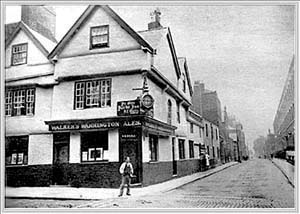 f
we
look
up
Watergate
Street,
on
the
right
is
one of the
few
examples
of
a
town
house
by Thomas
Harrison,
builder
of
the Grosvenor
Bridge, Northgate and Castle: Watergate
House was
built
in
1820 for Henry Potts, Clerk of the Peace for the County of Cheshire. Harrison's villas were usually stuccoed but his use of brick with stone dressings may have been used here to allow the house to blend in with the older houses in Watergate Street. f
we
look
up
Watergate
Street,
on
the
right
is
one of the
few
examples
of
a
town
house
by Thomas
Harrison,
builder
of
the Grosvenor
Bridge, Northgate and Castle: Watergate
House was
built
in
1820 for Henry Potts, Clerk of the Peace for the County of Cheshire. Harrison's villas were usually stuccoed but his use of brick with stone dressings may have been used here to allow the house to blend in with the older houses in Watergate Street.
In 1907, it became the first headquarters of the Army Western Command. Western Command stretched from Hadrian's Wall on the Scottish border to Tewkesbury in Gloucestershire and included Lancashire, Cheshire, wales and the West Midlands and, from 1907 to 1972, the garrison city of Chester was its HQ. The Army eventually outgrew Watergate House and moved into temporary premises in Boughton in 1935 until a vast, purpose-built neo-Georgian building was completed overlooking the River Dee at Handbridge in 1938.
A
little
further
on we encounter the traffic noise and stench of Nicolas
Street,
now part
of
the
modern Inner
Ring
Road.
On
the
right-hand
side
once
stood
the
ancient Yacht
Inn (of which more below)-
seen
above
in
a
photograph
of
c.1900,
which
shows
the
view
up
the street
towards Chester Castle.
It
is
hard
to
believe
that
only
forty
ago,
this
vista
remained
almost
unaltered.
But then the Yacht, the venerable Church of St. Martin and every other bulding seen on the left hand side of the photograph was demolished for road widening and
today
this
quiet
scene
seems difficult
to
imagine.
The
fine
row
of
town
houses
that still extend along
the
western
side
of
Nicolas
Street
were
designed
by Joseph
Turner,
who
also
built
the
Watergate
and Bridgegate,
and
erected
in
1780-81.
They
were
formerly
known
as Pill-Box
Terrace because
of
the
number
of
doctors
residing
and
practicing
there- Chester's Harley Street.
(Joseph Turner's massive tomb is in the Overleigh Cemetery, Handbridge. Today it is shamefully neglected, virtually invisible among the undergrowth but here is a photograph of it by the author, taken about 20 years ago when it was somewhat more accessible...)
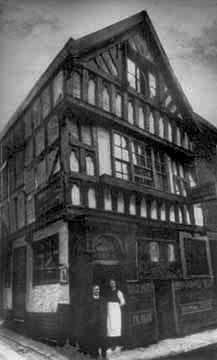 Watergate
Street
was
always a
place
of
great
bustle
and
business
as
it
was
the
main
entrance
to
the
wharves
and
crane
on
the
river,
which
formerly
approached
much
nearer
to
the
city.
As
the
Dee
silted
up,
so
the
importance
of
the
port
declined,
but
nevertheless,
in
1637
there
was
still
sufficient
business
to
justify
building,
opposite
the
Yacht,
a
new Customs
House. Watergate
Street
was
always a
place
of
great
bustle
and
business
as
it
was
the
main
entrance
to
the
wharves
and
crane
on
the
river,
which
formerly
approached
much
nearer
to
the
city.
As
the
Dee
silted
up,
so
the
importance
of
the
port
declined,
but
nevertheless,
in
1637
there
was
still
sufficient
business
to
justify
building,
opposite
the
Yacht,
a
new Customs
House.
Bear
in
mind
that
the Port
of
Chester-
which
technically
still
exists-
at
that
time
stretched
from
Barmouth
on
the
west
coast
of
Wales
to
Morcambe
Bay
in
northern
Lancashire. Flintshire landowner and travel writer Thomas
Pennant (1726-98) wrote that "In
this
tract
are
several
other
ports,
subordinate
to
the
comptroller
of
Chester,
and
even Liverpool is
styled a
creek
of
the
Port
of
Chester".
The
Customs
House
still
exists,
and
having
been
used
for
a
number
of
purposes
over
the
years,
today
houses
a
restaurant. Our photograph (below) shows the stone coat of arms atop the building and behind it, the tower of Holy Trinity Church, also known as The Guildhall.
Should you find yourself in need of refreshment at this point, you will find, just across the road, an establishment that, though it may share its name with the long-defunct Customs House, is very much alive and well. During our researches into the vanished pubs and inns of Chester, we found over and over the situation of ancient hostelries being extensively rebuilt during the 19th century but retaining their old names and licences. Some, however, escaped, and here is one- a genuine 17th century pub, the splendid Customs House Inn. It was originally a town house built in 1637 for Thomas and Anne Weaver (after who the little lane next to it, Weaver Street, is named) and you can still see their initials carved on the front. Once called The Star Inn, the pub was extended in the 18th century to incude the old Row and the house next door. Our photograph shows it in the 19th century- is that the landlord standing proudly in its doorway?- but it looks much the same today and serves some of the best-kept beers in town.
Returning to the old Yacht Inn, it was
described
in
the
19th
century
as "without
exception
the
most
picturesque
and
curious
of
all
our
Chester
inns" and
a
century
before
that
was
considered "the
premier
hostelry
in
the
city
on
its
most
important
street".
Both the London and Ireland stage coaches called at its door and it was noted for its feasts, entertainments and good accomodation. However, the
great
churchman, satirist and author Jonathan
Swift was
somewhat
less
enthusiastic...
My landlord is civil, but dear as the devil:
Your pockets grow empty with nothing to tempt ye:
The wine is so sour, t'will give you the scour:
The beer and the ale are mingled with stale:
The veal is such carrion, a dog would be weary on:
All this I have felt for I live on a smelt.
|
Swift was a frequent visitor to Chester, passing through on his way to and from Ireland and his duties as Dean of Dublin Cathedral. He did not seem to greatly enjoy the experience, especially when his stay in the city was extended due to bad weather at the port- by his time the wharves in Chester itself had become unusable and he would have had to travel a few miles by coach to the satellite port of Parkgate along the Wirral coast. During one of these enforced delays, he invited a number of dignitaries from the Cathedral to join him for a meal at the Yacht, but none of them bothered to turn up. Infuriated and insulted, with his diamond ring he scratched into one of the windows:
| Rotten without and mould'ring within, this place and its clergy are all near akin |
Swift
did
not,
however,
confine
his
comments
to
Chester's
clergy,
as
is
hilariously
illustrated
in
the
following:
The walls of this town
Are full of renown,
And strangers delight to walk round 'em;
But as for the dwellers,
Both buyers and sellers,
For me, you may hang 'em or drown 'em. |
By the
mid-nineteenth century, the old inn had fallen on hard times; in 1853 it was described as "now reduced to very humble pretensions compared to its former character" and, a century on, had become just another street corner pub. Then, in 1965, the
ancient Yacht, its
windows
and
scratchings-
together
with
every
other
building
on
the
left-hand
side
of
the
photograph
above-
were
bulldozed
during
the
creation
of
the Inner
Ring
Road,
and
their
foundations
and cellars now
lie
beneath
the
left-hand carriageway
of
busy
Nicolas
Street. To learn much more about the vanished inns of Chester, go here- here is the old Yacht's own page.
In
July
2000, Watergate
Street
has
become
the
latest
of
Chester's
main
streets
to
be
completely
resurfaced-
the
old
tarmac
having
been
replaced
by
attractive
stone
setts.
While
on
the
subject
of
road
conditions,
here's
a final
offering
from
Jonathan
Swift
concerning
the
state
of
the
highroads
he
was
forced
to
endure
on
his
journeys
between
London
and
Chester...
When soon by every hillock, rut and stone,
In each other's faces by turns were thrown...
Sweet Company! Next time, I do protest, Sir,
I'd walk to Dublin ere I'd ride to Chester. |
Just
as
the
modern
view
from
the
Watergate
provides
rather
a
challenge
to
the
imagination
in
evoking
the
scenes
of
yesteryear,
so
too
the
following
short
stretch
of
Chester's
city
walls.
Very
pleasant,
but
rather
mundane-
and
in
a
sense
providing
a
brief
relief
from
the
continuous
magnificence
of
spectacle
and
history
we
have
thus
far
experienced
during
our
journey.
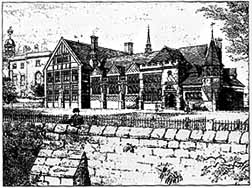 So,
descending
from
the
Watergate,
we
leave
behind
us
the
noise
and
traffic,
and
enter
leafy City
Walls
Road. So,
descending
from
the
Watergate,
we
leave
behind
us
the
noise
and
traffic,
and
enter
leafy City
Walls
Road.
Priory
and
Prison
In
the
middle
ages,
this
entire
area,
from
the
site of the newly-completed HQ Building to
the
fine old
towers on
the
northwest
corner
(which
we
will be
visiting later)-
and
stretching
back
beyond
the
present
Inner Ring
Road-
were
occupied
by
the
buildings
and
estates
of
various religious
foundations,
the
area
not
becoming
built
up
until
the
late
18th
century.
Indeed,
when
one
studies old
maps of
the
city,
it
is
amazing
just
how
much
land
inside
the
walls
remained distinctly rural in character;
used
for
grazing,
agriculture
and
gardens,
the Deanery
Field at
the
northeast
corner
being
the
sole
survivor
today.
The
wall
here,
as
with
the
stretch
along
Nun's
Road,
is
not
readily
apparent
until
we
look
over
the
parapet
on
our
left
and
see
the
sheer
drop
down
to
the
playing
fields
below
and
the
massive
sandstone
buttresses
that
extend
all
along
the
outside
of
the
West
Wall.
(They
may
be
seen
in
an
old
photograph
on
the
next
page). These
attractive
playingfields
and
tennis
courts
belong
to
the Queen's
School for
girls,
which
you
can
see
on
the
other
side
of
the
road.
The
school
had
been
founded
in
1878,
"for
the
education
of
the
daughters
of
the
middle
classes"
and
had
originally
occupied
a
large
18th
century
house-
100
Watergate
Flags-
on
the
corner
of
City
Walls
Road
and
Watergate
Street,
which,
as
we
learned
earlier,
had
been
built
on
the
site
of
an
extra-mural
Roman
bath
house.
It
was
considered
an
ideal
location
for
the
new
school,
despite
its
reputation
for
being haunted.
In
1806-8,
a new City
Gaol
and
House
of
Correction was
erected
where the school now stands
and its first
prisoners
were transfered
here
when
the
ancient Northgate Gaol was
demolished.
Designed by the prolific Chester architect Thomas Harrison, whose works we have encountered throughout our wanderings, it was built of brick at a cost of £3,500 and contained a gaol in the western half for remand prisoners awaiting trial and a house of correction on the east, for those found guilty of 'misdemeanours'- lesser crimes. Debtors also 'enjoyed' their own separate accomodation here. Each building was shaped like a cross with a square courtyard within each angle. Everything was surrounded by a high wall with two separate entrances, each with its stone porch on four Doric columns.
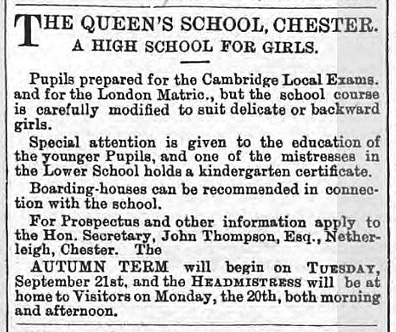 Until
the
gaol's
eventual
closure,
those
citizens
so
inclined
could
assemble
along the City Walls opposite to
witness
public
executions
carried
out
on
a
scaffold
mounted
above
the
gaol's
main
entrance.
No
doubt
the
crowds
would
have
attracted
refreshment
sellers,
hawkers,
and
the
like,
shouting
their
wares-
the
resulting
racket
doubtlessly resulting
in
frequent
fallings-out
with
the
nursing
staff
of
the Infirmary next
door! Until
the
gaol's
eventual
closure,
those
citizens
so
inclined
could
assemble
along the City Walls opposite to
witness
public
executions
carried
out
on
a
scaffold
mounted
above
the
gaol's
main
entrance.
No
doubt
the
crowds
would
have
attracted
refreshment
sellers,
hawkers,
and
the
like,
shouting
their
wares-
the
resulting
racket
doubtlessly resulting
in
frequent
fallings-out
with
the
nursing
staff
of
the Infirmary next
door!
Right: an advertisment for the Queen's School from the Chester Courant, 1897: "the school course is carefully modified to suit deliacte or backward girls"..
In 1856, the local author Thomas Hughes, in his Stranger's Guide to Chester wrote, "Surely the day is not far distant when 'death by the hangman' will be a punishment unknown to the criminal code of England! What adds to the evil, as far as Chester is concerned, is that the authorities of the City are compelled, by some antediluvian charter, to see execution done on every condemned criminal within the County, though for what reason this especial 'honour' was first conferred on the citizens, is an enigma susceptible of no clear solution".
(Another 113 years were to pass until Hughes' wish was granted and capital punishment was finally done away with in Britain in 1969- except for Northern Ireland, where they had to wait until 1973. Go here for a grim history of the subject).
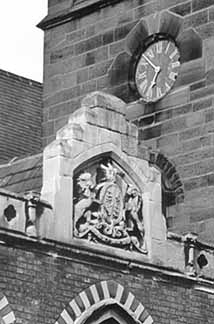 A 1940s contributor to the Cheshire Sheaf, when a small boy, overheard a friend of his father relating that, while a passenger on the railway (which can still be seen crossing the viaduct on the far side of the Roodee), he had seen the body of a criminal suspended on the gallows erected on this gaol. A 1940s contributor to the Cheshire Sheaf, when a small boy, overheard a friend of his father relating that, while a passenger on the railway (which can still be seen crossing the viaduct on the far side of the Roodee), he had seen the body of a criminal suspended on the gallows erected on this gaol.
Left: the Coat of Arms of the City of Chester on top of the old Customs House with the tower of Holy Trinity Church- the Guildhall- behind.
A rather less serious crime was reported in the pages of the long-defunct Chester Courant in 1833: "Thomas Andrews, William Hughes and John Harding, three children of larger growth, were charged with a breach of the peace on Sunday afternoon. The youngsters have lately spent their Sabbaths at the brick kilns in Newtown, where they play at marbles, pitch & toss, and other amusing and interesting games: they were so engaged on Sunday last when they were disturbed by Worrall, the constable, who deposed that they made a great disturbance. As governor Jepson’s spacious yards- at the city gaol- afford excellent accommodation for such instructive games, the Mayor politely directed that they be admitted and remain there until they can find some person to promise on their behalf that they shall not again disgrace themselves by playing on the Sabbath".
You can see what the place looked like in an old illustration on the next page. It was demolished in 1872. The old prison fire bell, which once hung over the debtor's yard, was long displayed at the Pied Bull Inn in Northgate Street. What later became of it is unknown.
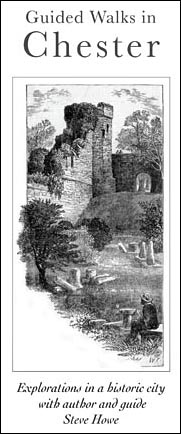 • Cheshire West & Chester Council's excellent Archive & Local Studies System allows free access to some remarkable databases of information, including the City Gaol registers 1808-42. These list criminals, their crimes and- often brutal- punishments: "3rd Jan 1816. Disobeying an Order in Bastardy of a female bastard child for 2s per week belonging to the Parish of St Olave in Chester. Committed as above for same in case of a male bastard". "16 Oct 1815. Breaking and entering warehouse of Edward Roberts and William Roberts in said city and stealing 2 pieces of sugar value £6. Tried 26th Oct 1815 and found guilty. Sentenced to transportation for 7 years." "Insulting several well dressed women about 3pm on City Walls by indecently exposing and shaking at them his private parts against common decency and breach of the peace. (punishment not recorded)". • Cheshire West & Chester Council's excellent Archive & Local Studies System allows free access to some remarkable databases of information, including the City Gaol registers 1808-42. These list criminals, their crimes and- often brutal- punishments: "3rd Jan 1816. Disobeying an Order in Bastardy of a female bastard child for 2s per week belonging to the Parish of St Olave in Chester. Committed as above for same in case of a male bastard". "16 Oct 1815. Breaking and entering warehouse of Edward Roberts and William Roberts in said city and stealing 2 pieces of sugar value £6. Tried 26th Oct 1815 and found guilty. Sentenced to transportation for 7 years." "Insulting several well dressed women about 3pm on City Walls by indecently exposing and shaking at them his private parts against common decency and breach of the peace. (punishment not recorded)".
The site of the old gaol was acquired by the Duke of Westminster, who offered it to the rapidly-expanding school for the erection of a new building. Designed in the Tudor Gothic style by A. E. Oulde of Newgate Street, it was opened by the Duke on March 7th 1883. Above, you can see the architect's original design drawing for the building- the Infirmary may be seen to its left.
Up
to
the
opening
of
the
new
building,
the
school
had
gone
under
the
title
of
'The
Chester
School
for
Girls'
but
the
Duke
had
a
quiet word
in
the
ear
of
Queen
Victoria,
who
commanded
that "the
school
in
question
shall
be
styled
the Queen's School".
In
1997,
the
school
had
high
hopes
of
being
able
to
expand
into
the
disused
1761 Infirmary building-
which
we
will
visit
soon-
but
were
gazumped
by
property
developers
at
the
last
moment.
Instead,
they
acquired
the
former City
Walls
Hotel, just
in
front
of
us,
where
they
have
successfully
developed
their
new
sixth
form
centre.
Just
before
the
Queen's
School
is Stanley
Place,
a
group
of
fine
houses
facing each other across a small cobbled street and dating
from
the
1780s.
The Chester Courant of May 1778 advertised the development thus, "There is now to be let for building on, several hundred yards of land in the Yacht-Field, near the Watergate, within and adjoining the City Walls, being a most convenient, dry and healthy situation, commanding a very pleasing prospect of the Flintshire hills and River Dee, with a great part of the enclosed lands recovered from the sea. Its extent will admit of erecting elegant houses, that may be formed into a square that will open to the City Walls, and its situation may, with great propriety, be considered as in the country".
The aforementioned Yacht Field had, in pre-Reformation times, formed part of the estates belonging to the monastery of the Franciscan Grey Friars, of whom we learned in our previous chapter. When the grand houses were eventually built,
a
private garden
was laid out
between
the
two
sides
of
the
street where cars park today.
The
distinctive
porch
seen
on
the
end
of
the
right-hand
terrace
is
Chester's
last
surviving example
(and one of very few in the entire country) of
a Sedan
Porch.
The
sedan
chair
was
carried
by
two
servants
into
the
centre
of
the
open
porch,
thereby
allowing
the
occupant
to
enter
or
leave
the
house
without
being
exposed
to
the
elements.
A
Miss
Piper
wrote
of
them: "They
came
into
the
parlour
and
got
full
of
warm
air,
and
nipped
you
up
and
carried
you
tight
and
cosy
into
another
warm
room
where
you
could
walk
out
without
having
to
shew
your
legs
by
going
up
steps
or
down
steps".
Cheese
and
Linen
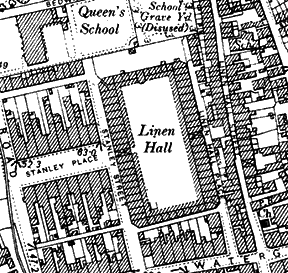 At
the
far
end
of
Stanley
Place
stood
between
1235
and
1538
the
monastery
of
the
Franciscan Greyfriars and
later
Chester's Linen
Hall occupied
the
site.
This
was
built
in
1778
by
Irish
linen
merchants
as
a
depot
containing
many
shops
in
a
spacious
area
from
which
their
cloth-
to
the
measure
of
millions
of
yards-
was
distributed
by
wagon
and
pack
horse
throughout
the
kingdom. At
the
far
end
of
Stanley
Place
stood
between
1235
and
1538
the
monastery
of
the
Franciscan Greyfriars and
later
Chester's Linen
Hall occupied
the
site.
This
was
built
in
1778
by
Irish
linen
merchants
as
a
depot
containing
many
shops
in
a
spacious
area
from
which
their
cloth-
to
the
measure
of
millions
of
yards-
was
distributed
by
wagon
and
pack
horse
throughout
the
kingdom.
Here we can see the Queen's School and the large area the Linen Hall once occupied in this detail from the 1896 Chester OS map and a photograph of it is below.
Linen
fairs
were
held
on
5th
July
and
10th
October
and
even
though
a
heavy
duty
of
twopence
on
every
100
yards
was
imposed,
it
was
a
profitable
import
through
the Port
of
Chester.
After
the
linen
trade
declined,
the
building
was
utilised
as
a
cheese
store
and
market, trading in the world-renowned Cheshire cheese.
It was said to have been a sleepy and quiet place except during the Cheese Fairs, when in a few hours thousands of pounds could change hands. The cheese was sold by the hundred-weight and only under exceptional circumstances could a single cheese be bought.
(Traveller
and
writer George
Borrow was,
however,
less
than
impressed
with
the
Cheshire
cheese
and
ale
he
was
served
when
staying
at
the
Pied
Bull
Inn
in Northgate
Street 150
years
ago...)
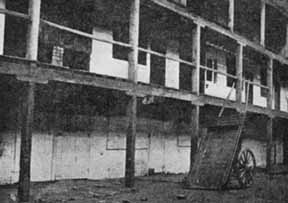 It
is
said
that
local
cheese
making
originated
with
the
Romans,
but
it
has
certainly
been
made
here
for
many
centuries,
and
delicious Cheshire
Cheese was
shipped
to
the
world
in
special
'cheese
ships'
which
departed
from
the 'Cheese
House
Quay' in
Crane
Street,
just
up
the
road
from
the
Watergate. Towards the end of the 19th century, these quays of the so-called Old Port went into decline as the River Dee continued to silt up and the trade was transferred to the railways. It
is
said
that
local
cheese
making
originated
with
the
Romans,
but
it
has
certainly
been
made
here
for
many
centuries,
and
delicious Cheshire
Cheese was
shipped
to
the
world
in
special
'cheese
ships'
which
departed
from
the 'Cheese
House
Quay' in
Crane
Street,
just
up
the
road
from
the
Watergate. Towards the end of the 19th century, these quays of the so-called Old Port went into decline as the River Dee continued to silt up and the trade was transferred to the railways.
A very similar- if somewhat grander- structure in Halifax, West Yorkshire- the magnificent Piece Hall- will give you a strong idea of how Chester's Linen Hall once looked. Theirs remains as a thriving commercial centre and leisure facility and is, in fact, a Grade I listed building, but Chester's is sadly long gone. When it was demolished, the cheese fairs were transferred to the Market Hall in Town Hall Square.
From
1919,
the
site
of
the
old
Linen
Hall
had
been
occupied
by
stables
used
to
accommodate
horses
taking
part
in
the
races
on
the Roodee.
In May
2001,
however,
the Chester
Race
Company announced
plans
to
demolish
them
in
order
to
allow the development of
new
housing
on
the
site. Nearly two years later, in May 2003, we learned that developers Taylor Woodrow were aspiring to build 144 apartments in 4 and 6-storey blocks on the site. Their architects say the new properties will 'reflect' features of the windows and brickwork of neighbouring Georgian buildings but will include "contemporary timber panels and rendering".
There is currently little demand for any more apartments to be built in Chester but the stables were nontheless demolished in May 2009 as, it was claimed, vagrants and 'undesirables' were living in them and the area has, for the moment, been transformed into a car park, awaiting a future time of prosperity when buildings may once again rise there...
And
now, moving just a short distance, we
see
on
our
right
the
old Chester
Royal
Infirmary...
Curiousities
from
Chester's
History
no. 23
|
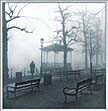


 Watergate
Street
was
always a
place
of
great
bustle
and
business
as
it
was
the
main
entrance
to
the
wharves
and
crane
on
the
river,
which
formerly
approached
much
nearer
to
the
city.
As
the
Dee
silted
up,
so
the
importance
of
the
port
declined,
but
nevertheless,
in
1637
there
was
still
sufficient
business
to
justify
building,
opposite
the
Yacht,
a
new Customs
House.
Watergate
Street
was
always a
place
of
great
bustle
and
business
as
it
was
the
main
entrance
to
the
wharves
and
crane
on
the
river,
which
formerly
approached
much
nearer
to
the
city.
As
the
Dee
silted
up,
so
the
importance
of
the
port
declined,
but
nevertheless,
in
1637
there
was
still
sufficient
business
to
justify
building,
opposite
the
Yacht,
a
new Customs
House. So,
descending
from
the
Watergate,
we
leave
behind
us
the
noise
and
traffic,
and
enter
leafy City
Walls
Road.
So,
descending
from
the
Watergate,
we
leave
behind
us
the
noise
and
traffic,
and
enter
leafy City
Walls
Road. Until
the
gaol's
eventual
closure,
those
citizens
so
inclined
could
assemble
along the City Walls opposite to
witness
public
executions
carried
out
on
a
scaffold
mounted
above
the
gaol's
main
entrance.
No
doubt
the
crowds
would
have
attracted
refreshment
sellers,
hawkers,
and
the
like,
shouting
their
wares-
the
resulting
racket
doubtlessly resulting
in
frequent
fallings-out
with
the
nursing
staff
of
the
Until
the
gaol's
eventual
closure,
those
citizens
so
inclined
could
assemble
along the City Walls opposite to
witness
public
executions
carried
out
on
a
scaffold
mounted
above
the
gaol's
main
entrance.
No
doubt
the
crowds
would
have
attracted
refreshment
sellers,
hawkers,
and
the
like,
shouting
their
wares-
the
resulting
racket
doubtlessly resulting
in
frequent
fallings-out
with
the
nursing
staff
of
the  A 1940s contributor to the Cheshire Sheaf, when a small boy, overheard a friend of his father relating that, while a passenger on the railway (which can still be seen crossing the viaduct on the far side of the Roodee), he had seen the body of a criminal suspended on the gallows erected on this gaol.
A 1940s contributor to the Cheshire Sheaf, when a small boy, overheard a friend of his father relating that, while a passenger on the railway (which can still be seen crossing the viaduct on the far side of the Roodee), he had seen the body of a criminal suspended on the gallows erected on this gaol.

 At
the
far
end
of
Stanley
Place
stood
between
1235
and
1538
the
monastery
of
the
Franciscan Greyfriars and
later
Chester's Linen
Hall occupied
the
site.
This
was
built
in
1778
by
Irish
linen
merchants
as
a
depot
containing
many
shops
in
a
spacious
area
from
which
their
cloth-
to
the
measure
of
millions
of
yards-
was
distributed
by
wagon
and
pack
horse
throughout
the
kingdom.
At
the
far
end
of
Stanley
Place
stood
between
1235
and
1538
the
monastery
of
the
Franciscan Greyfriars and
later
Chester's Linen
Hall occupied
the
site.
This
was
built
in
1778
by
Irish
linen
merchants
as
a
depot
containing
many
shops
in
a
spacious
area
from
which
their
cloth-
to
the
measure
of
millions
of
yards-
was
distributed
by
wagon
and
pack
horse
throughout
the
kingdom.  It
is
said
that
local
cheese
making
originated
with
the
Romans,
but
it
has
certainly
been
made
here
for
many
centuries,
and
delicious Cheshire
Cheese was
shipped
to
the
world
in
special
'cheese
ships'
which
departed
from
the 'Cheese
House
Quay' in
Crane
Street,
just
up
the
road
from
the
Watergate.
It
is
said
that
local
cheese
making
originated
with
the
Romans,
but
it
has
certainly
been
made
here
for
many
centuries,
and
delicious Cheshire
Cheese was
shipped
to
the
world
in
special
'cheese
ships'
which
departed
from
the 'Cheese
House
Quay' in
Crane
Street,
just
up
the
road
from
the
Watergate.